|
H U N T I N G
VADÁSZAT - VADVILÁG |
|
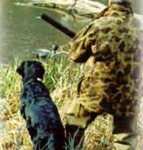 |
|
General: In the past uncontrolled hunting was one of the main causes of the extinction or near extinction of many kinds of wildlife. However, today wild animals are protected by laws that regulate hunting that is laws which limit the methods of taking certain animals, specify the times during which they may be hunted.
On the other hand, population of a species may become so large that its own survival or the survival of other species is threatened.
The number of such species must be reduced by controlled hunting or by restoring their natural enemies.
If a species is threatened by disease (rabies, ticks), sanitation measures must be taken in its habitat to prevent the disease from spreading. | |
| |
| Vocabulary |
| |
hunting
hunt(-ed)
hunter
extinct(-ed)
extinction
|
vadászat
vadászik
vadász
kihal, kipusztul
kihalás, kipusztulás; kiirtás |
kind
wildlife
wild
protect(-ed)
protected
species, (pl) species
population
threaten(-ed)
survival
enemy
disease
rabies
tick
sanitation
measure
habitat
|
fajta, féle; faj
élővilág; vad(állomány)
vad; vadon élő; vadon termő
véd
védett, védelem alatt álló
faj (rendszertani)
populáció; népesség
fenyeget
fennmaradás, túlélés
ellenség
betegség, kór
veszettség
kullancs
egészségügyi; járványügyi
intézkedés, lépés; rendszabály
élőhely | |
| |
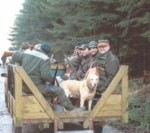 |
|
Hunting Rights
In almost every country, hunters must apply for a hunting licence and buy insurance to obtain the rigth to hunt. However, they may shoot game only during the open season; such activity in the months of the closed season is strictly forbidden. | |
| |
Kinds of Hunting
Stalking (stillhunting), hunting in the rutting and pairing season (with roe, hare or partridge calls to lure the game), battue-shooting (coursing), hunting from a raised hide (stand), beating (driving), trapping, hawking and shooting from a butt. |
|
 | |
| |
right
apply applied applied
hunting licence
insurance
obtain (-ed)
shoot shot shot
game
open season
closed season
forbid forbade forbidden
stalking
rut
pairing season
roe deer
hare
partridge
call
lure (-d)
battue-shooting
raised hide
beating
trapping
hawking
shooting from a butt
|
jog
kérvényez, igényel
vadászati engedély, vadászigazolvány
biztosítás
megszerez; hozzájut
lő; lelő; kilő
vad(állat); vadhús
vadászidény
vadászati tilalmi időszak
tilt
(be)cserkészés
szarvasbőgés
párzási időszak
őz
mezei nyúl
fogoly
hívó jel; itt: síp
csalogat
körvadászat
magasles
fel)hajtás
csapdázás
solymászat
uhuzás | |
| |
CAPTURING
The wildlife manager very often captures animals to reduce their population density, restock, control damage and conduct research. Some capture techniques are presented here:
|
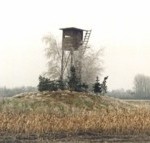 |
|
|
|
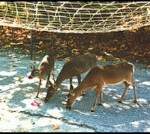 | |
| |
| |
| |
| kind of animal |
recommended capture methods |
suggested marking devices |
|
|
|
| small mammals |
box, traps, hand-capture,
pitfall traps |
mutilation, freeze branding, collars,
ear tags |
|
|
|
| large mammals |
box, traps, modified leg-hold traps, drive nets, drop nets, tranquilizers, hand capture |
ear tags, freeze-branding, mutilation, colour-coded collars |
|
|
|
| birds |
nets, box, traps, tranquilizers, walk-in traps |
coloured leg and neck bands, wing tags, tatooing, mutilation, feather dyes | |
| |
capture
wildlife manager
population density
restock
damage
conduct
research
mammal
recommend(-ed)
suggest(-ed)
mark(-ed)
device
trap
pitfall trap
mutilation
freeze froze froze(n)
brand(-ed)
collar
tag
net
tranquilizer
feather
dye
|
elfogás; befogás;
zsákmány; elfog, foglyul ejt
vadgazda
populáció sűrűség
állatokkal ellát; benépesít
kár
vezet; lefolytat
kutatás
emlős
javasol, ajánl
tanácsol, javasol, ajánl
jelöl; jelez
eszköz, mód; szerkezet, készülék
csapda
verem
csonkítás
fagyaszt
megbélyegez, jelöl; beéget
(nyak)örv; fémgyűrű, fémkarika
címke; jelölés
háló
nyugtató
madártoll
festék | |
| |
|
EURASIAN DEER |
| |
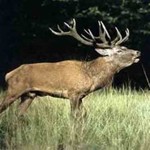 |
|
The red deer (Cervus elaphus) and the fallow deer (Dama dama) are the only two species with a natural habitat in Europe.
Red deer: An adult stag stands about 1.3 metres high at the shoulder and may have a full set of 12-pointed antlers reaching another 1.2 metres in height. Females are slightly smaller and do not grow antlers. Stags live alone or in male herds during spring and summer, but in autumn with their antlers velvet and their coats in breeding bloom they establish territories and gather their harems. This period is known as the rut. Fierce, aggressive battles between rival stags often |
take place. One spotted calf or fawn is born the following May or June after about 250 days gestation.
Note: The plurals deer, sheep mean a lot of animals of the same breed; deers, sheeps are used to indicate different breeds. | | |
| |
| Vocabulary |
| |
deer
red deer (Cervus elaphus)
fallow deer (Dama dama)
stag
shoulder
antler
female
male
herd
velvet
coat
rut
breeding season/time
bloom
calf (pl) calves
fawn
gestation
|
szarvas; őz
gímszarvas
dámvad
szarvasbika; hím, kan, bika
váll, mar(magasság)
agancs; agancsosság
nőstény
hím
csorda; falka, nyáj, konda
barkás, háncsos (fejlődő agancs pihés hártyája)
szőrzet, bunda
(szarvas) bőgés; dürgés (fajdé)
párzási időszak, üzekedés
(teljes) szépség; szín
borjú (szarvas; bivaly; bölény; elefánt)
fiatal őz, őzgida; szarvasborjú
vemhesség | |
| |
 |
|
Fallow deer
A medium-sized deer that stands just under l metre at the shoulder. The spotted, fawn, summer coat moults to a uniform grey in winter. The male has broadly flattened antlers and a very prominent Adam's apple. His rutting cry is a very deep-toned grunt. One offspring is born in June or July. Among the 18 species of Eurasian deer are: the Axis deer (Axis axis), the sambar (Cervus unicolor) and the sika deer (Cervus nippon). Among most species of deer only the | |
| males have antlers (except for the caribou and reindeer). Most male deers are called bucks, however, male caribou and moose are called bulls and male red deer are stags or harts. Most female deers are called does but female caribou and moose are cows and female red deer are hinds. Most young deer are called fawns, but the young of the caribou, elk and moose are calves. |
|
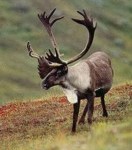 | |
| |
| Vocabulary |
fawn
moult(-ed)
moulting time
flattened
grunt
offspring
axis deer (Axis axis)
sambar deer (C. unicolor)
sika deer (C. nippon)
caribou (Rangifer caribou)
reindeer (C. tarandus)
buck
moose(Alces americanus)
bull
hart
doe
cow
hind
|
világosbarna, sárgásbarna
elhullat, elhány
vedlési tollhullatási idő
lapos, laposra formált
morgás, dörmögés
utód, ivadék, leszármazott
dél-ázsiai pettyes szarvasfajta
számbár szarvas
szikaszarvas
karibou kanadai rénszarvas
rénszarvas, tarándszarvas
bak, hím (szarvas; nyúl; antilop)
jávorszarvas
bika, hím állat
szarvasbika
őzsuta; dámvadtehén
tehén, nőstényállat (szarvas; bivaly; elefánt)
szarvastehén, szarvassuta | |
| |
 |
|
Roe deer
These herbivore ungulates have adapted well to the changing environment and are widely spread in Hungary. They prefer to dwell near the edges of forests where trees, grasses and the nearby fields supply food and bushes are a good hiding place from predators though they are absent in some areas. | |
| Foxes, wild cats may attack very young fawns but they do not seriously threaten the roe deer population in Hungary. They roam in groups in which both males and females can be seen. When eating or resting they usually face into the wind with erected ears to catch sounds and smells. They live about 10 to 12 years. |
| |
| Vocabulary |
roe deer (Carpeolus carpeolus)
herbivore
ungulate (pl) ungulata, ungulates
adapt(-ed)
environment
dwell(-ed)
bush
spread spread spread
hide hid hidden
predator
fox
attack(-ed)
roam(-ed)
erect(-ed)
smell
|
őz
növényevő (állat)
patás
alkalmazkodik
környezet
tartózkodik, időzik; lakik
bokor, cserje
elterjed
rejtőzik, megbúvik
ragadózó
róka
megtámad
barangol, kószál
feltart, magasba emel
szag
| |
| |
| Adjudication of Some Trophies: In the case of red deer the length of the antler, brow-tine, bay, circumference of the burr Crose, (coronet), beam, crown, the number of points, the bez-tine and the tips of points are decisive factors. As for the roe deer colour and pearling are important. For fallow deer the length and breadth of the palm, the edge of the palms should be considered. When scoring a moufflon or an ibex the length of the horn, its spread and ribbing and the curve are evaluated. |
| |
| Vocabulary |
adjudication
length
brow tine (point, snag)
bay (bez)
circumference
burr (rose, coronet)
beam (main trunk)
crown (royal, tray)
number of points
bez-tine
tip of points
pearling
breadth
palm
consider(-ed)
edge of the palms
score(-d)
moufflon
ibex
horn
spread
ribbing
curve
evaluate)
beam (main trunk)
|
megítélés; odaítélés; (bírói) döntés
hosszúság, hossz
szemág
középág
körméret, kerület
rózsa
szár
korona
ágak száma
jégág
ágvég
gyöngyözés
szélesség
lapát
tekintetbe vesz; mérlegel
csipkézettség
pontoz
muflon
kőszáli kecske
szarv; csiga(szár)
terpesztés
bordázat, gyuruzodés
csavarodottság
értékel
agancsszár | |
| |
 |
|
WILD SPECIES of PIGS and HOGS
These even-toed ungulates are non-ruminants. They do not chew the cud, have a simple digestive system with a two-chambered stomach. The wild species are very hairy and often the upper and lower canines grow very long, forming sharp, curved tusks. Pigs are unusual among ungulates. The females or sows give birth to large litters so have several pairs of mammae to provide milk for the young. Pigs are |
| omnivorous. The wild boar (Sus scrofa): Today the largest population survive in various parts of Asia. The piglets are attractive with horizontal stripes running along their bodies. This colouration may assist in concealing the youngsters. The marks are important visual signals, enabling the mother to keep sight of them. | |
| |
pig
hog
toe
even-toed
odd-toed
ruminant
chew (-ed) the cud
stomach
canine
tusk
sow
litter
litter (-ed),
mamma (pl) mammae
omnivorous
omnivore
wild boar (Sus scrofa)
boar
piglet
stripe
colouration
conceal (-ed)
youngster
enable (-d)
|
disznó; vaddisznómalac
sertés, disznó
Cláb)ujj
párosujjú
páratlan ujjú
kérődző
kérődzik
gyomor; bendő
szemfog; kapófog
agyar (vaddisznó; elefánt)
koca, anyadisznó, emse
alom (egy ellésnyi kölyök)
kölykezik, almot vet, megellik
emlő, csecs, mellbimbó
mindenevő
mindenevő (állat)
vaddisznó
kan; vadkan
kismalac
csík
színezet, színeződés
elrejt, rejteget; rejtőzködik
kicsi; kölyök (állaté)
képessé tesz; lehetővé tesz | |
| |
WILD SHEEP
They originally came from the plateaus and mountains of Central Asia. The largest wild sheep, the argali lives there. Wild sheep walk on hooves that are divided into 2 toes. The horn of the ram is usually curved.
The European representative is the moufflon (Ovis musimon). It was sucessfully introduced into Hungary in the 19th century. The ribbing of their massive horns enables us to estimate the age of the animal. They live in bands. The rams fight during the breeding season. The ewe has about 6 months gestation. 1 or 2 lambs are born in April or May. The one-year old lamb is called a jerk. Moufflons feed on grasses, shootings of bushes etc. They are very modest in their diet.
|
|
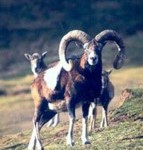 | |
sheep (pl) sheep
hoof (pl) hooves, hoofs
ram
intoduce (-d)
ribbing
estimate (-d)
band
fight fought fought
ewe
lamb
feed fed fed
feed
jerk
shooting
modest
diet
|
juh
pata
kos
meghonosít
bordázat, ránc
értékel; felmér
csapat, csoport
verekszik; küzd, harcol
anyajuh
bárány
táplálkozik; él valamin; legel
takarmány
jerke
hajtás
szerény
táplálék; táplálkozás; étrend | |
| |
 |
|
GUNS
Guns are classified according to size. Hand-carried guns, called small arms include pistols, rifles and shotguns. Portable automatic weapons that can fire from 400 to 1,600 rounds of ammunition per minute are called machine guns. Gun size is expressed in terms of calibre, the inside diametre of the gun barrel. Most guns have spiral grooves, called rifling, on the | |
|
inside of the barrel. The rifling imparts a spiraling motion to a bullet.
Sporting guns,
most frequently used by huntsmen are: the single-loader, the repeater (also called a magazine rifle) and the triple-barrelled rifle (self-cocking gun).
|
|
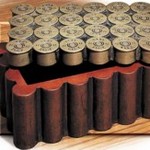 | |
| |
gun
small arms rifle
shotgun
portable
weapon
ammunition
machine gun
calibre (US) caliber
barrel
gun barrel
groove
rifling
impart (-ed)
motion
bullet
use (-d)
sporting gun
single-loader
load
repeater
magazine rifle
triple-barrelled rifle
self-cocker gun
cock
|
lőfegyver; puska; vadászfegyver
kézi lőfegyver/lőfegyverek
vont csövű lőfegyver;
vadászpuska
(sörétes)vadászpuska
hordozható; mozgatható fegyver
lőszer
gépfegyver
kaliber, űrméret
cső (ágyú; puska) puskacső
horony; huzagolás; vágat
huzagolás
(át)ad;
visz (mozgást) mozgás
golyó, lövedék
használ, alkalmaz
vadászfegyver, vadászpuska
egycsövű fegyver
töltet; töltény
ismétlő fegyver
ismétlő fegyver
3-csövű fegyver, "drilling" ismétlő
automata fegyver
ütőszeg; (régi fegyver: kakas) | |
| |
| Note: calibre, metre, diametre, centimetre, centre are caliber, meter, diameter, centimeter, center in American spelling. See the abbreviation: "US" in dictionaries. It refers to colour -color, colouration - coloration, barrelled - barreled etc. as well as to word usage, e. g.: hunter-huntsman, autumn - fall etc. |
| |
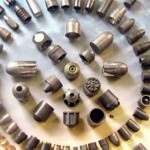 |
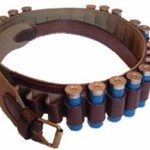
|
B U L L E T S
They consist of a metal core, fully or partly covered by a metal jacket. Bullets with full metal jacket keep their shape when they strike a target. However, partly jacketed bullets expand on impact. Most types of cartridges contain a bullet. Nearly all types of cartridges have a propellant, a primer and a casing. They differ in the type of projectile they contain. Cartridges fired by shotguns hold a number of metal pellets called shots. A small-shot cartridge has a cardboard case, charge, felt wad and different kinds of powder. A full-jacketed cartridge consists of a soft-lead core, powder charge a detonator cap and a percussion cap. | |
| |
core
jacket
strike struck struck
target
expand (-ed)
impact
cartridge
propellant
primer
casing
projectile
pellet
(small) shot
shot
shot (-ted)
cardboard
charge
felt wad
powder
lead
cap
detonator cap
pecussion cap
|
mag
burkolat; borítás; köpeny
talál; ütődik; behatol
cél, célpont
szétnyílik; kiterjed
becsapódás; ütődés
töltény; töltet; kartács
hajító töltet, hajító anyag
gyújtókupak; gyutacs
hüvely; tok, foglalat
röpítő/hajító (erő);lövedék, lőszer
sörét
sörét
lövés
megtölt (lőfegyvert)
karton(papír)
töltés, töltet
fojtás
puskapor; lőpor
ólom
gyutacs, gyújtófej, csappantyú; kupak, sapka
robbanókupak
gyujtókupak; "kapszli" | |
| |
| Note: The inside diametre of the gun barrel is measured in inches and hundredths of an inch or in millimetres and centi-metres. l inch = 25,399 millimetre |
| |
 |
|
|
|
DUCKS, GEESE and PHEASANTS
Ducks and geese are water-birds with webbed feet and dense plumage. Most have fiat bilis with | |
edges adapted for straining food. They are strong fliers and many migrate great distances. The males are usually very colourful, especially during the breeding season. The females are generally brown that provides good camouflage. Ducks include the familiar mallard, shoveler, garganey, teal, gadwall etc. They are often called dabbling or dipping ducks because they dabble in shallow water, upended to filter-feed their food.
Diving ducks include scoters, ferruginous ducks and others. | |
| |
duck
goose (pl) geese
webbed-foot (pl)-feet
plumage
bill
strain (-ed)
migrate (-d)
migratory bird
male
female
provide (-d)
camouflage
mallard (Anas platyrchynchos)
shoveler (Anas clyplata)
garganey (Anas querquedula)
teal (Anas crecca)
gadwall (Anas strepera)
dabble (-d)
dip (-ped)
dabbling, dipping duck
filter-feed
dive dove dove
diving duck
scoter
tufted duck (Aythya fuligula)
pochard (Aythya ferina)
ferruginous duck (Aythya nyroca)
|
réce, ruca, kacsa
lúd, liba
úszóhártyás láb
tollazat
csőr
húz; átszűr
költözik
vándormadár, költöző madár
gácsér; gúnár
tojó
biztosít; ad; szolgál
álcázás, leplezés
tőkés réce
kanalas réce
böjti réce
csörgő réce
kendermagos réce
márt(ogat)
lemerül
úszóréce
szürcsöl
lebukik; alámerül
bukóréce
(bukó)réce
kontyos réce
barátréce
cigányréce | |
| |
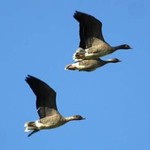 |
|
|
|
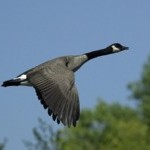 |
|
Geese
spend much of their time on land cropping and grazim grass. When they migrate, fly in V- formation maintaining contact with one another emitting long honking noises.The greylag goose is a heavy-looking bird with an orange beak and pink legs. It is the only wild goose which nests and hatches in Hungary. As it is protected, its hunting is prohibited in any hunting season. The white-fronted goose, which is smaller and darker than the greylag is also protected. Hunting of the bean goose is permitted. | |
| |
crop (-ped)
graze (-d)
grass
maintain (-ed)
emit (-ted)
honk (-ed)
honk
greylag goose (Anser anser)
beak
hatch (-ed)
prohibit (-ed)
hunting season
white-fronted goose
(Anser albifrons) bean goose (Anser fabalis)
permit (-ted)
|
gyűjtöget
legel
fű
fenntart, megőriz
kibocsát; hangot ad
gágog
gágogás, vadliba hangja
nyári lúd
csőr
költ (tojást),
tilt
vadászidény
nagylilik
vetési lúd
engedélyez; megenged | |
| |
 |
|
Pheasants
are ground birds with short, stout, down-curved bilis and large heavy feet Cwhich have 3 long toes in front and l short toe behind). Both male and female have long, pointed tails. The dull-brown colour of the female provides excellent camouflage for ground nesting. The males have bright plumage for court-ship, and perform elaborate courtship displays to attract the mate. They take no part in rearing their young (called chicks). | |
| |
pheasant (Phasianus)
pheasant-cock
pheasant-hen
pheasant-chick
tail
pointed
courtship
display
mate
rear (-ed) |
fácán
fácánkakas
fácántyúk
fácáncsibe
farok; faroktoll
hegyes végű
udvarlás
disz-/násztollazat; dürgés
(fácán)tyúk
nevel | |
| |
Rabbits and Hares
Most rabbits are smaller than hares and have shorter ears. A new-born rabbit is blind, has no fur and cannot move about; a new-born hare can see, has a coat of fine fur and can hop a few hours after birth. Rabbits and hares belong to the same order of the animal kingdom (Lagomorpha). They all have large, chisel-like, continuously growing front teeth (incisors) and a gap between the front teeth and the cheek-teeth. (They are similar to rodents in this respect). As their eyes are on the sides of the head, they see things behind and to the side better than in front.
The European brown hare (Lepus europaeus) has black-tipped ears. It does not burrow but nests in a
|
|
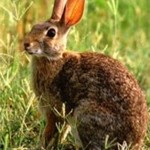 |
| hollow in coarse grass. The smaller European rabbit lives in extensive borrows or warrens. It has more litters than the brown hare and the doe rears them by herself. | |
| |
rabbit
hare
fur
hop (-ped)
order
animal kingdom
chisel-like
grow grew grown
incisor
cheek-tooth
rodent
burrow
hollow
extensive
warren
doe |
üregi nyúl mezei nyúl,
vadnyúl szőrzet, prém,
bunda
ugrándozik; szökell (őz)
rend
állatvilág
véső alakú
nő, növekszik
metszőfog
zápfog
rágcsáló
földalatti vacok, lyuk, odú
(nyúl; róka; vakond)
üreg; mélyedés
kiterjedt, terjedelmes
kotorék
nőstény (nyúl; menyét) | |
| |
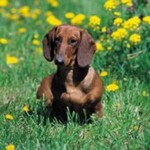 |
|
HOUNDS
Hounds hunt either by smell or by sight. Scent hounds such as beagles and foxhounds run with their nose to the ground to follow an animal scent. Some scent hounds bay while they are trailing game, i.e. they give out deep, long barks. Tall gazehounds or sight hounds were bred to hunt game by sight. Such gazehounds as the |
|
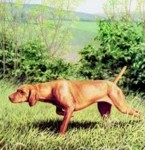 |
greyhound are used in the sport of dog racing.
Terriers (Scottish, bull, foxterrier) were originally bred to drive game out of holes in the ground. Most of the terrier breeds originated in England. They have a wiry coat and bushy beard. They help people by killing pests.
Retrievers (Golden retriever, Labrador) are good at finding and fetching game; they can retrieve birds from water.
Setters (Irish, Gordon) and pointers (German short-haired, Hungarian vizsla) point their body towards the game after locating it. Setters have long hair, while pointers have a short, smooth coat. | |
 |
|
The Hungarian short-haired vizsla is very intelligent and
obedient. It likes working in watery terrain as well. The wire-haired vizsla can be easily trained, good natured, and has an
excellent sense of smell.
|
|
 | |
Dachshunds are wire-haired. They are very good hounds for small game.
Spanieis (Cocker, Springer, Field) help hunters by going into
bushes and shrubs to spring the bird into air.
Note: With some exceptions (bloodhound, basset hound) the Hungarian name of a breed is usually the same as the original with the same spelling. That is why the reader of this collection will not find them listed separately in the vocabulary. |
| |
hound
smell
scent
beagle
foxhound
follow (-ed)
bay (-ed)
trail (-ed)
trail
bark
bark (-ed)
sight
gaze (-d)
breed bred bred
breed
hole
wiry
bushy
pest
retrieve (-d)
fetch (-ed)
smooth
pointer
point (-ed)
locate (-d)
obedient
terrain
train (-ed)
Dachshund (wire-haired)
spring sprang sprung
shrub
bloodhound
basset hound |
vadászkutya
szimat; szag
szag (vadé);
csapás, nyom (angol, egyenes lábú)
vadásztacskó, kopó, rókavadász
követ
csahol
nyomon követ
nyom
ugatás
ugat
látás, látóképesség
(mereven) néz
tenyészt
fajta, tenyészet
üreg; verem; vacok; odú; lyuk
drót(szerű)
bozontos, sűrű
kártékony állat, kártevő
elhoz, apportíroz; újra megtalál
érte megy, elhoz
sima
vizsla (fajta)
mutat, jelez; becéloz; áll (vadat kutya)
felderít; meghatároz, megjelöl
engedelmes, kötelességtudó
terület, terep
idomít
tacskó (drótszőrű)
ugrik; szökken (őz)
bozót, csalit
véreb
borzeb | |
| |
 |
|
FORESTS TO FEED WILD ANIMALS
The deciduous forests of the temperate zone are an ideal home for animal life. The crowns of trees and bushes provide a rich source of food and shelter for insects, birds and small mammals (stoat, weasel, hedgehog). Denizens of the tree canopy include birds of prey such as the goshawk, buzzard, magpie and jay. Conifers also provide food (buds, bark, leaves |
| and cones) for squirrels, hares and birds (eaten by martens, owls, lynxes, wolves and bears). The European lynx has adapted well in its selection of food (it lives on the species most easily caught). Among foxes the red fox (Vulpes vulpes) has survived better in Eurasia. It may cause great damage in pheasant preserves and attacks wild piglets or sometimes young fawns. Wolves are rare visitors to Hungarian forests as they have been largely exterminated in the |
|
 | |
| temperate areas. The main habitats of the brown bear (Ursus arctos) are now the Pyrenees, Scandinavia and eastern Europe. It can feed on all kinds of plants, berries, honey from wild bee nests or on fish. | |
| |
deciduous
source of food
shelter
insect
stoat
weasel
hedgehog
denizen(of forests)
tree canopy
bird of prey/raptor
goshawk
buzzard
magpie
jay
conifer
bud
bark
leaf (pl) leaves
cone
squirrel
pine marten
stone marten
owl
lynx
damage
pheasant preserve
game preserve
catch caught caught
rare
exterminate (-d)
wolf (pl) wolves
bear
plant
berry
bee |
lombhullató
táplálékforrás
menedék
rovar
hermelin
menyét
sündisznó
(erdő)lakó
lombsátor
ragadozó (madár)
héja
egerészölyv
szarka
szajkó
tűlevelű
rügy
kéreg
falevél
toboz
mókus
nyuszt
nyest
bagoly
hiúz
kár; veszteség
fácános
vadaskert
elfog, megfog; utolér
ritka
kiirt, kipusztít
farkas
medve
növény
bogyó
méh | |
| |
 |
|
CONSERVATION of WILDLIFE
It is not only the conservationists' but also the hunters' obligation and responsibility to try to maintain the biological balance of forests and /or wetlands (with special attention to threatened, endangered and rare species) so as to conserve the biological diversity of ecosystems.
It is not an easy task when agriculture and | |
| urbanization lay claim to more and more lands, chemicals and other pollutants can enter the food chain of wildlife. A modern hunter should be a conservationist himself. With his experience he can provide a lot of data on wildlife and help preserve nature. |
|
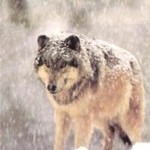 |
| |
conservation
conservationist
obligation
responsibility
balance
wetland
endangered
conserve (-d)
biological diversity
ecosystem
lay laid laid claim to sg
pollutant
pollution
food chain
experience
data
preserve (-d) |
védelem
természetvédő
kötelesség
felelősség
egyensúly
vizes terület
veszélyeztetett
fenntart; megóv
biodiverzitás
ökoszisztéma
igényt támaszt valamire
szennyező (anyag)
szennyeződés; szennyezés
tápláléklánc
tapasztalat
adat
fenntart; megvéd, óv | |
| |
|
COLLECTION of WORDS |
| |
| A |
|
adapt (-ed)
adjudicate (-d)
adjudication
ammunition
animal
animal kingdom
antler
apply applied applied
arms
axis deer (Axis axis)
attack (-ed)
attract (-ed) |
alkalmazkodik
megítél; eldönt
megítélés; odaítélés; (bírói) döntés
lőszer
állat
állatvilág
agancs; agancság
kérvényez, igényel
fegyver(ek)
dél-ázsiai pettyes szarvas
megtámad
vonz | |
| |
| B |
|
balance
band
bark
bark (-ed)
barrel
basset hound
battle
battue-shooting
bay (-ed)
bay (bez)
beagle
bear
beak
beam (main trunk)
bean goose (Anser fabalis)
beating
bee
berry
bez-tine
bill
biological diversity
bird of prey
bloodhound
boar
brand (-ed)
breadth
breed bred bred
breed
breeding season/time
brow tine
buck
bud
bull
bullet
burr(rose, coronet)
burrow
bush
bushy
butt
buzzard |
egyensúly
csapat, csoport
ugatás; kéreg
ugat
cső (ágyú; puska)
borzeb
harc, küzdelem, csata
körvadászat
csahol
középág
(angol egyenes lábú) vadásztacskó, kopó
medve
csőr
szár (agancs)
vetési lúd
(fel)hajtás
méh
bogyó
jégág
csőr
biodiverzitás
ragadozó(madár)
véreb
kan; vadkan
megbélyegez, jelöl; beéget
szélesség
tenyészt
fajta, tenyészet
párzási időszak, üzekedés,
barcogás, rigyetés
szemág
bak,hím (szarvas; nyúl; antilop)
rügy
bika; hím állat
golyó, lövedék
rózsa
földalatti vacok, lyuk,
odú (nyúl, róka, vakond)
bokor, cserje
bozontos, sűrű
domb, töltés(golyófogó)
egerészölyv | |
| |
| C |
|
calf (pl) calves
calibre (US) caliber
call
camouflage
canine
caribou(Rangifer caribou)
cartridge
cardboard
cap
capture
capture (-d)
casing
catch caught caught
cause
cause (-d)
chambered
chain
charge
cheek-tooth
chew (-ed) the cud
chisel-like
closed season
coat
cock
collar
colouration
conceal (-ed)
conduct (-ed)
cone
conifer
conservation
conservationist
conserve (-d)
consider (-ed)
core
coursing
courtship
cow
crop (-ed)
crown (royal, tray)
cud
curve
curved
|
borjú (szarvas; bivaly; bölény; elefánt)
kaliber, űrméret
hívó jel; itt: síp
álcázás,leplezés
szemfog; kapófog
karibou, kanadai rénszarvas
töltény; töltet; kartács
karton(papír)
gyutacs,gyújtófej, csappantyú;
kupak, sapka
elfogás; befogás; zsákmány
elfog, foglyul ejt
hüvely; tok, foglalat
elfog, megfog; utolér
ok
okoz, előidéz
recés, redőzött
lánc
töltés, töltet
zápfog
kérődzik
véső alakú
vadászati tilalmi időszak
szőrzet, bunda
ütőszeg; (régi fegyver: kakas)
kakas (szárnyas)
(nyak)örv; fémgyűrű, fémkarika
színezet, színeződés
elrejt, rejteget; rejtőzködik
vezet, lefolytat
toboz
tűlevelű
védelem
természetvédő
fenntart; megóv
tekintetbe vesz; mérlegel
mag
körvadászat
udvarlás
tehén; nőstény állat
(szarvas; bivaly; elefánt)
gyűjtöget
korona
visszakérődzött falat/takarmány
csavarodottság
csavarodott; hajlott | |
| |
| D |
|
dabble (-d)
dabbling,dipping duck
Dachshund
damage
danger (-ed)
data
deciduous
dense
density
deer (pl) deer
denizen (of a forest)
detonator cap
device
diet
dip (-ped)
display
dive dove dove
diving duck
doe
dog-racing
disease
driving
duck
dwell (-ed)
dye |
márt(ogat)
úszóréce
tacskó
kár; veszteség
veszélyeztet
adat(ok)
lombhullató
sűrű, tömör
sűrűség
szarvas; őz
(erdő)lakó
robbanókupak
eszköz,mód; szerkezet, készülék
táplálék; táplálkozás; étrend
lemerül
dísz-(násztollazat; dürgés)
lebukik; alámerül
bukóréce
őzsuta; dámvadtehén;
nőstény (nyúl; menyét)
agárverseny
betegség, kór
hajtás
réce, ruca, kacsa
tartózkodik, időzik; lakik
festék | |
| |
| E |
|
ecosystem
emit (-ted)
enable (-d)
endangered
enemy
edge
edge of the palms
environment
erect (-ed)
estimate (-d)
evaluate (-d)
even
even-toed
ewe
expand (-ed)
experience
extensive
exterminate (-d)
extinct (-ed)
extinction
|
ökoszisztéma
kibocsát, hangot ad
képessé tesz; lehetővé tesz
veszélyeztetett
ellenség
szél, él
csipkézettség
környezet
fenntart, magasba emel
felmér; becsül; értékel
értékel
páros(szám)
párosujjú
anyajuh
szétnyílik; kiterjed
tapasztalat
kiterjedt, terjedelmes
kiirt, kipusztít
kihal, kipusztul
kihalás, kipusztulás; kiirtás,kipusztítás | |
| |
| F |
|
fallow deer (Dama dama)
fawn
feather
feed fed fed
feed
felt-wad
female
ferruginous duck
(Aythya nyroca)
fetch (-ed)
fierce
filter-feed
fire (-d) at sg/sy
flat
flattened
follow (-ed)
food chain
forbid forbade forbidden
forest
fox
foxhound
freeze froze froze(n)
fur |
dámvad
fiatal őz, őzgida; szarvasborjú;
világosbarna, sárgásbarna(szín)
madártoll
táplálkozik; él valamin; legel
takarmány
fojtás
tojó; nőstény
cigányréce
értemegy, elhoz
vad, heves; harapós (kutya)
szürcsöl
rálő valamire/valakire
lapos
laposra formált, lapos
követ
tápláléklánc
tilt
erdő
róka
rókavadász (kutya)
fagyaszt
szőrzet, prém, bunda | |
| |
| G |
|
gadwall (Anas strepera)
game
game preserve
gap
garganey (Anas querquedula)
gaze (-d)
gestation
goose (pl) geese
goshawk
grass
graze (-d)
greylag goose (Anser anser)
groove
grow grew grown
ground
grunt
gun
gun barrel
|
kendermagos réce
vad(állat) vadhús
vadaskert
rés, hézag, köz
böjti réce
(mereven) néz
vemhesség
lúd, liba
héja
fű
legel
nyári lúd
horony; huzagolás; vágat.
nő, növekszik
föld, talaj
morgás, dörmögés
lőfegyver; puska; vadászfegyver
puskacső | |
| |
| H |
|
habitat
hairy
hare
hart
hatch (-ed)
hawk
hawking
hedgehog
herbivore
herd
hide
hide hid hidden
hind
hog
hole
hollow
honk
honk (-ed)
hoof (pl) hooves, hoofs
hop (-ped)
horn
hunt (-ed)
hunter
hunting license
hunting season
|
élőhely
szőrös
mezei nyúl
szarvasbika
költ (tojást)
héja; solymászatra használt
ragadozó madár,
solymászat
sündisznó
növényevő (állat)
csorda, falka, nyáj, konda
leshely
rejtőzik, megbúvik
szarvastehén, szarvassuta
sertés, disznó
üreg; verem; vacok; odú; lyuk üreg;
mélyedés
gágogás, liba hangja
gágog
pata
ugrándozik; szökell (őz)
szarv; csiga(szár)
vadászik
vadász
vadászati engedély, vadászigazolvány
vadászidény | |
| |
| I |
|
ibex
impact
impart (-ed)
include(-ed)
incisor
insect
insurance
|
kőszáli kecske
becsapódás, ütődés
(át)ad; visz (mozgást)
beleért, beleszámít; magában foglal
metszőfog
rovar
biztosítás | |
| |
| J |
|
jay
jacket
jerk
|
szajkó
burkolat, borítás;köpeny
jerke | |
| |
| K |
|
keep kept kept
sight of sg kind
|
szemmel tart, figyel
vmt fajta, féle; faj | |
| |
| L |
|
lay laidlaid claim to sg
lead
leaf (pl) leaves
litter
litter (-ed)
cartridge
load
locate (-d) lure (-d)
lynx
|
igényt támaszt; jogot formál vmire
ólom
falevél
alom (egy ellésnyi kölyök)
kölykedzik, almot vet, megellik
töltet; töltény
felderít; meghatároz; megjelöl
csalogat
hiúz | |
| |
| M |
|
machine gun
magazine rifle
magpie
maintain (-ed)
male
mallard (Anas platyrchynchos)
mamma (pl) mammae
mammal
mark (-ed)
mate
measure
migrate (-d)
migratory bird
modest
moose (Alces americanus)
motion
moufflon
moult (-ed)
moulting time
mutilation
|
gépfegyver
ismétlő fegyver
szarka
fenntart; megőriz
hím; gácsér; gúnár
tőkés réce
emlő, csecs, mellbimbó
emlős
jelöl; jelez
(fácán)tyúk
intézkedés, lépés;rendszabály
költözik
vándormadár, költöző madár
szerény
jávorszarvas
mozgás
muflon
elhullat, elhány
vedlési/tollhullatási időszak
csonkítás | |
| |
| N |
|
natural
nest
nest (-ed)
net
number of points |
természetes; természeti
fészek
fészkel; tanyázik, lakik
háló
ágak száma | |
| |
| O |
|
obedient
obligation
obtain(-ed)
odd
odd-toed
offspring
omnivore
omnivorous
open season
order
owl |
engedelmes, kötelességtudó
kötelesség
megkap; hozzájut
páratlan (szám)
páratlan ujjú
utód, ivadék, leszármazott
mindenevő (állat)
mindenevő
vadászidény
rend (rendszertani)
bagoly | |
| |
| P |
|
pairing season
palm
partridge
pearling
pellet
percussion cap
permit (-ted)
pest
pheasant
pheasant-chick
pheasant-cock
pheasant-hen
pheasant preserve
pig
piglet
pitfall trap
plant
plumage
pochard (Aythya ferina)
point
pointer
point (-ed)
pointed
pollutant
pollution
population density
portable
powder
predator
preserve (-d)
prey
primer
prohibit (-ed)
projectile
propellant
protect (-ed)
protected
protection
provide (-d) |
párzási időszak
lapát (ti. agancsé)
fogoly
gyöngyözés
sörét
gyújtókupak, "kapszli"
engedélyez; megenged
kártékony állat, kártevő
fácán
fácáncsibe
fácánkakas
fácántyúk
fácános
disznó; vaddisznómalac
kismalac
verem
növény
tollazat
barátréce
vég; csúcs, hegy
Vizsla(fajta)
mutat, jelez; becéloz; áll (kutya vadat)
kihegyezett végű, hegyes
szennyező (anyag)
szennyeződés; szennyezés
populáció sűrűség
hordozható; mozgatható
puskapor; lőpor
ragadozó (állat)
fenntart; véd, megóv
zsákmány, préda
gyutacs; gyújtókupak
tilt
röpítő/hajító (erő); lövedék, lőszer
hajítótöltet, hajítóanyag
véd
védett
védelem
biztosít; ad, szolgál | |
| |
| R |
|
rear (-ed)
rabbies
rabbit
raised hide
ram
raptor
rare
recommend (-ed)
red deer (Cervus elaphus)
reindeer (Cervus tarandus)
repeater
research
responsibility
retrieve (-d)
restock (-ed)
ribbing
rifle
rodent
rifling
roe deer (Carpeolus carpeolus)
roam (-ed)
ruminant
rut
|
nevel
veszettség
üregi nyúl
magasles
kos
ragadozó (madár)
ritka
javasol, ajánl
gímszarvas
rénszarvas, tarándszarvas
ismétlő fegyver
kutatás, kutató munka
felelősség
apportíroz, elhoz; újra megtalál
állatokkal ellát; benépesít
bordázat, ránc, gyűrűződés
vont csövű lőfegyver; vadászpuska
rágcsáló (állat)
huzagolás
őz
barangol, kószál
kérődző
bőgés (szarvas); dürgés (fajd) | |
| |
| S |
|
sambar deer (Cervus unicolor)
sanitation
scent
score (-d)
scoter
self cocker gun
sheep (pl) sheep
shelter
shoot shot shot
shooting
shooting from a butt
shot
shotgun
shot (-ted)
shoulder
shoveler (Anas clyplata)
shrub
sight
single-loader
sika deer (Gervus nippon)
small arms
smell
source of food
sow
species (pl) species
sporting gun
spotted
spread
spread spread spread
spring sprang sprung
squirrel
stag
stalking
stoat
stomach
stillhunting
stone marten
strain (-ed)
stripe
suggest (-ed)
survival
survive (-d) |
számbár szarvas
egészségügyi; járványügyi
szag (vadé); csapás, nyom
pontoz
(bukó)réce
automata, ismétlő fegyver
juh
menedék
lő; lelő; kilő
hajtás (növényé); lövés
uhuzás
sörét
sörétes vadászpuska
megtölt (lőfegyvert)
váll
kanalas réce
bozót, csalit
látás, látóképesség
egycsövű fegyver
szikaszarvas
kézi lőfegyver/lőfegyverek
szag
táplálékforrás
koca, anyadisznó, emse
faj
vadászfegyver, vadászpuska
foltos, pettyes
terpesztés
elterjed
ugrik; szökken (őz)
mókus
szarvasbika; hím, kan, bika
(be)cserkészés
hermelin
gyomor; bendő
(be)cserkészés
nyest
húz; átszűr
csík
tanácsol, javasol, ajánl
fennmaradás, túlélés
életben marad, fennmarad | |
| |
| T |
|
tag
target
teal (Anas crecca)
threaten (-ed)
terrain
tick
tip of points
trail
trail (-ed)
train (-ed)
tranquilizer
trap
trapping
triple-barrelled rifle
tufted duck (Aythya fuligula)
tusk |
címke, jelölés
cél, célpont
csörgő réce
fenyeget
terület, terep
kullancs
ágvég
nyom
nyomon követ
idomít
nyugtató
csapda
csapdázás
3 csüvű fegyver,"drilling"
kontyos réce
agyar (vaddisznó; elefánt) | |
| |
| U |
|
|
ungulate (pl) ungulata, ungulates
use (-d)
usage |
patás
használ, alkalmaz
használat,alkalmazás | |
| |
| V |
|
| velvet |
barkás, háncsos
(a fejlődő agancs pihés hártyája) | |
| |
| W |
|
warren
weapon
weasel
webbed foot (pl)-feet
wetland
white-fronted goose
(Anser albifrons)
wild
wild boar (Sus scrofa)
wildlife
wildlife manager
wire-haired
wiry
|
kotorék
fegyver
mennyét
úszóhártyás láb
vizes terület
nagylilik
vad, vadon élő, vadon termő
vaddisznó
élővilág; vadállomány
vadgazda
drótszőrű
drót(szerű) | |
| |
| Y |
|
| youngster |
kicsi; kölyök (állat) | |




